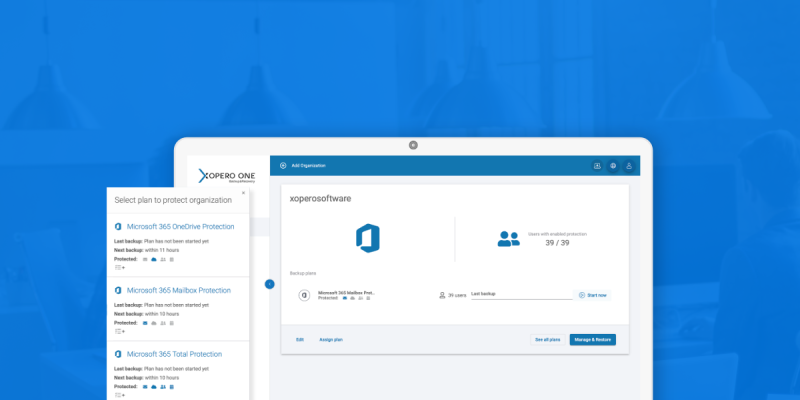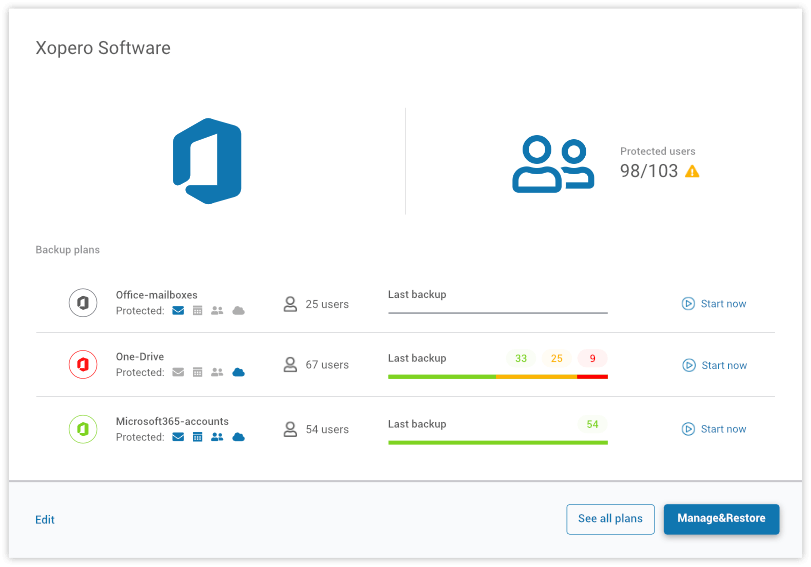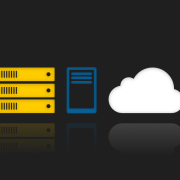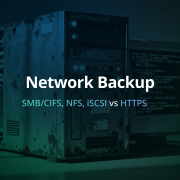
Microsoft 365: Best Practices for cloud backups
Modern enterprises are increasingly relying on cloud solutions, which not only offer convenience and availability from any place in the world but also significantly increase work efficiency. Microsoft Office 365 is a leading cloud platform that provides users with a wide range of tools for collaboration and communication, such as Exchange Online, SharePoint Online, OneDrive for Business, and Teams. With its help, companies can store documents, share resources, and communicate in real time.
This article aims to discuss the best practices for creating and managing backups of data stored in Office 365. We will explain why an Office 365 backup is essential, what risks may arise from the lack of proper backup procedures, and how to effectively implement and manage backups to ensure the highest possible security of corporate data.
Why is Microsoft Office 365 Cloud Backup Essential?
Despite the numerous advantages offered by cloud services, one cannot overlook the challenges associated with data security. Data loss can be caused by various factors, from simple user errors to technical failures, and even sophisticated cyberattacks. While Microsoft does provide a robust infrastructure and defensive mechanisms, the full responsibility for backups and data protection lies with the users. This necessitates understanding and implementing an effective backup strategy aimed at minimizing the risk of data loss and ensuring continuity under all circumstances.
1. Understanding Responsibilities and Risks
Shared Responsibility Model
In the Microsoft Office 365 environment, a shared responsibility model is in place where Microsoft ensures the security of the cloud infrastructure and the application itself, while the responsibility for protecting the data generated and stored by users rests with the organizations themselves. This means that every company must actively manage its data, which includes regularly creating backups, monitoring access, and responding quickly and effectively to potential data security incidents.
Potential Risks
Lack of a proper backup strategy carries the risk of data loss due to various factors, such as:
- Human Error: Accidental deletion or overwriting of important files.
- Malware Attacks: Particularly ransomware, which can encrypt data making it inaccessible without paying a ransom.
- Technical Failures: Include physical damage to servers or software errors that can lead to data loss.
- Natural Disasters: Such as fires or floods, which can destroy local data servers.
Scenarios in Case of Failure
Examples that illustrate the consequences of lacking an effective backup strategy include:
- Loss of Critical Data: This prevents the recovery of essential business information, leading to significant financial losses.
- Business Interruptions: Caused by the lengthy time needed to recover data from unsophisticated backups or the absence of backups, which negatively impacts business operations and company reputation.
- Compliance Violations: With data protection regulations such as the GDPR, resulting from the lack of adequate backups of personal data, which can lead to severe financial and legal penalties.
2. Understanding Microsoft 365 Data Retention Policies
Standard Microsoft Policies
Microsoft Office 365 offers defined retention policies designed to protect user data in various scenarios, including account deletion or individual items such as emails or documents. For example, deleted mailboxes are retained for 30 days, providing organizations a window to recover them. However, these standard policies may not suffice for all organizational needs, especially those needing to comply with stricter regulatory requirements for long-term data archiving.
Gaps in Standard Policies
While Microsoft 365’s retention policies are designed to meet common needs, there may be gaps requiring additional attention:
- Short Retention Periods: For some data, such as financial records or personal data, a longer retention period than Microsoft’s standard offerings may be required.
- Limited Flexibility: Microsoft’s policies may not offer enough flexibility to tailor retention settings individually for different types of data or organizational departments.
Customizing Policies
Organizations should consider implementing their own additional backup solutions to secure data according to their unique needs:
- Choosing Backup Tools: Selecting external backup tools that can complement or replace the standard features offered by Microsoft 365.
- Personalizing Backup Schedules: Establishing their own backup schedules that better meet organizational and regulatory needs.
3. Selection and Implementation of a Backup Solution
Choosing the right backup tool involves several key factors, such as scalability, reliability, cost, ease of use, and compliance with data protection laws. It is also important to choose a solution that offers flexible data recovery options, allowing easy restoration of individual items or entire data sets as needed.
Selection Criteria
When selecting a backup tool, consider the following criteria:
- Compliance with Regulations: Ensure the chosen solution meets local and international data protection standards.
- Data Recovery: The ability to quickly and effectively restore data, both at the individual object level and entire systems.
- Scalability: The ability to adapt the solution to the growing amount of data and changing needs of the organization.
- Technical Support: Availability of technical support, which can be crucial in case of problems or failures.
Implementation Process
The implementation of the chosen backup solution should be methodical:
- Planning: Define backup goals, select data for backup, and establish a schedule.
- Installation and Configuration: Implement the tool according to organizational needs, configure automation, and establish access policies.
- Testing: Conduct tests to ensure the backup is complete and that data can be effectively recovered in various failure scenarios.
4. Testing and Backup Verification
The importance of regular testing and verification of backups is crucial to ensure that data can be quickly and effectively recovered when needed. Testing also helps identify potential issues in the backup process that may be overlooked during daily system operations.
Testing Methods
- Restore Tests: Regularly restoring data from backups to a test environment helps verify whether recovery processes work correctly.
- Failure Simulations: Simulating various failure scenarios checks the system’s response and its ability to quickly restore business operations.
- Reviews and Audits: Regular internal and external audits can help maintain a high level of security and compliance with applicable regulations.
Documentation of Processes
Maintaining accurate documentation of backup and data recovery processes is critical. This documentation should include detailed information about the backup schedule, applied methods, and the history of tests and their outcomes.
User Education and Cost Optimization
Raising user awareness about the importance of data security and proper backup practices is key to minimizing the risk of human errors that can lead to data loss.
- Training: Regular training on safe technology usage, recognizing phishing attempts, and other cybersecurity threats.
- Communication: Establishing clear procedures and communication lines that help users report suspicious activities or data issues.
Cost Optimization
Effectively managing the costs associated with data backup can lead to significant savings for the organization.
- Process Automation: Introducing automation in backup processes can reduce labor and operational errors.
- Data Retention Policy: Implementing effective data retention policies that help eliminate unnecessary or outdated data, reducing storage costs.
Reliable Microsoft 365 Backup with Xopero ONE
Xopero ONE Backup & Recovery is a technologically advanced data backup solution specifically designed to support businesses in protecting their data stored in Microsoft 365. This solution offers a full spectrum of data protections for data in Exchange Online, SharePoint Online, OneDrive for Business, and Teams, ensuring that all valuable information is secure and readily accessible in the event of a system failure, cyberattack, or user error.
Key Features and Benefits
Xopero ONE is distinguished by numerous features that provide comprehensive data protection in the Microsoft 365 environment:
- Automatic Backups: Xopero ONE performs automatic backups, ensuring ongoing protection without the need for manual intervention. Users can set backup schedules according to their needs, allowing for flexible backup management.
- Data Encryption: All data is encrypted during both transmission and storage, minimizing the risk of unauthorized access. Data security is a priority in every aspect of Xopero ONE’s operation.
- Granular Recovery: The system allows for quick and effective recovery of not just entire datasets but also individual files, folders, or emails, which is crucial for specific recovery needs.
- Ease of Management: Xopero ONE offers an intuitive user interface that makes it easy to manage backup processes, monitor activity, and quickly recover data. Managing backups is straightforward and does not require advanced technical knowledge.

Xopero ONE supports all key applications included in Microsoft 365.
Why Xopero ONE for Microsoft 365 Backup?
Xopero ONE stands out among other backup and recovery solutions, due to its comprehensiveness, reliability, and user-centric focus. By supporting all major services included in Microsoft 365, it provides a unified solution for managing backups and recovering data. It is an ideal solution for companies that value data security, ease of use, and minimizing the risk of losing important information.
Office 365 Backup – Supported Applications

Xopero ONE supports all key applications included in Microsoft 365, providing a versatile and effective backup solution.
Summary
Implementing an effective backup strategy for Office 365 is essential to ensure data protection against loss and to maintain business operation and ensure business continuity throughout. Regular system testing, user education, and cost optimization related to data backup are crucial.
Companies using Office 365 should promptly assess their current backup strategies and consider implementing recommended changes to secure their business operations against unexpected downtimes and data loss.







